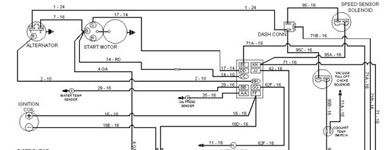
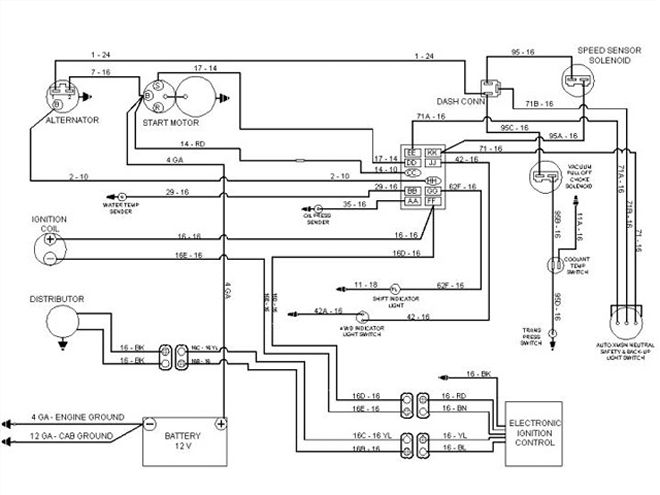
Wiring - the mere mention of the subject brings chills to the spine of most performance car do-it-yourselfers. For most, its part of the sacred trio of chores usually left to hired guns - bodywork/paint, upholstery, and wiring. But for those willing to do some research, practice a bit of trial and error, and spend the time and effort required any of these chores can be (and are often) completed by those of us with at least a modicum of technical know-how.
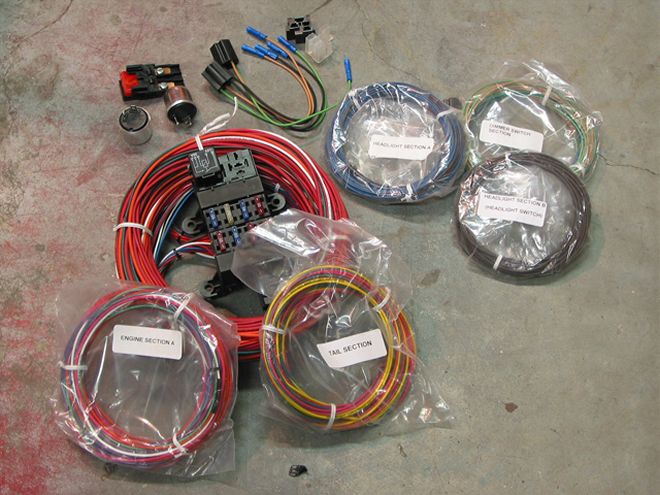 Here's a shot of a typical aftermarket harness assembly. These days we're lucky enough to have a lot of excellent companies manufacturing complete high-quality wares that allow automotive wiring to fall within most of our DYI comfort zones.
Here's a shot of a typical aftermarket harness assembly. These days we're lucky enough to have a lot of excellent companies manufacturing complete high-quality wares that allow automotive wiring to fall within most of our DYI comfort zones.
We've got on good thing going for us when it comes to wiring our beloved street rods these days - a few smart men and the companies they represent that offer us access to complete prefabricated harnesses and related components which eliminate much of the heartache and labor involved in the wiring process. That said, I'm going to proceed under the assumption that very few will attempt a complete rewiring job without taking advantage of what these companies have to offer and will attempt the procedure armed with the components and accompanying instructions provided with said components.
Okay, now comes my end of the deal. Here, instead of trying to rewrite my version of the instructions you got with your wiring kit, I'm going to try and provide some usable information, tips, and tricks that'll hopefully arm you with the confidence and motivation to get the job done.
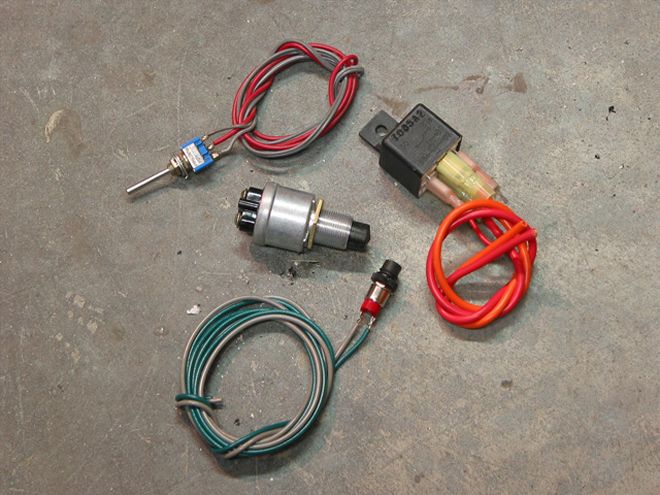 Relays are a must in automotive wiring. High-load circuits like headlamps, and starters can and will overpower the ratings of most switches degrading them over time. Relays basically cushion these switches from those high loads letting them operate with much less stress.
Relays are a must in automotive wiring. High-load circuits like headlamps, and starters can and will overpower the ratings of most switches degrading them over time. Relays basically cushion these switches from those high loads letting them operate with much less stress.
My first tip is extremely important and one you've most likely heard more times than you can count - read the damn instructions! I know, I know - it's not in our nature to do such a thing, that is, until we're hopelessly dazed and confused. But when it comes to a job like this, you just have to swallow your pride, go hide in the crapper, and read 'em from front to back - hey, you can always deny you read 'em when the job is done . . . Now that you've agreed to read the instructions before you start, here's the additional information I promised.
VOLTS, AMPS, AND OHMS
In order to fully understand how the wiring in your car works let's take a look at the element we're trying to harness -- electricity. The three most basic units in electricity are voltage, current, and resistance. Voltage is measured in volts, current is measured in amps and resistance is measured in ohms. A neat analogy to help understand these terms are plumbing pipes. The voltage is equivalent to the water pressure, the current is equivalent to the flow rate, and the resistance is like the pipe size.
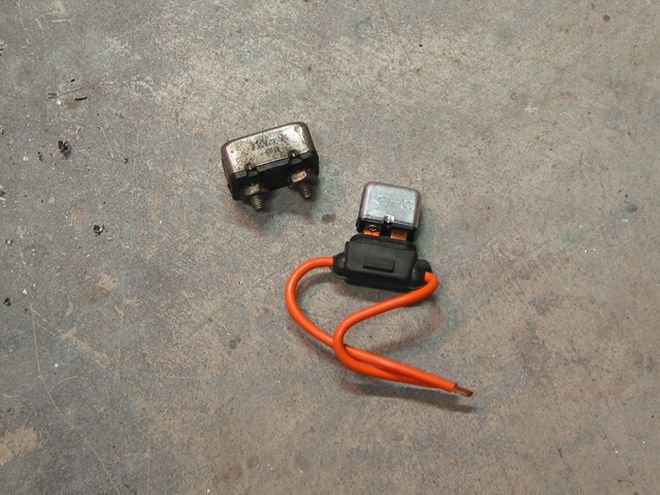 Circuit breakers are good insurance. They operate much like a fuse (protecting systems from voltage spikes and shorts) by breaking a circuit before massive damage occurs.
Circuit breakers are good insurance. They operate much like a fuse (protecting systems from voltage spikes and shorts) by breaking a circuit before massive damage occurs.
THE COMPONENTS
Okay, for the most part, the harness consists of about forty seven and a half miles of wire, give or take a mile or two. Thankfully they're different colors and labeled to boot. There's also a fuse box and normally a bunch of relays (little black cubes with spade terminals sticking out) as well. The instructions will tell you what circuit they're for and what wires to hook up to 'em, but what are they for and how do they work?
RELAYS
A relay is a gizmo that allows low current to activate a much more powerful current without overloading a switch. Circuits like those for headlights, air conditioning, or power windows for example require a lot of amperage to start and/or run. Another way to describe it is as a "switched-switch" or "triggered-switch" capable of handling higher amperage than the switch it's replacing. A typical relay only needs about 120 milliamps (0.120 amps) to be triggered and held closed but can then supply 30, 40 or more amps (depending upon its rating) to the load being fed. By making the relay the main switch in the headlight circuit and using the headlight switch as the trigger for the relay, we shift the amperage load off the headlight switch and onto the relay, which is designed to do the job.
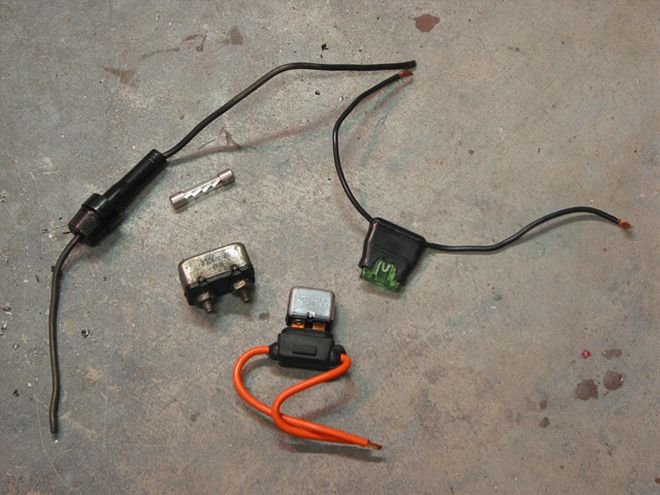 Here's a shot of three different types of circuit protection - the age-old glass fuse, the modern spade-type fuse, and an inline breaker.
Here's a shot of three different types of circuit protection - the age-old glass fuse, the modern spade-type fuse, and an inline breaker.
BREAKERS
A circuit breaker is a safety that's designed to protect an electrical apparatus from damage caused by overload or short circuit. Unlike a fuse, which operates once and then has to be replaced, a circuit breaker can be reset (either manually or automatically) to resume normal operation.
FUSES
A fuse performs the same chore as a breaker but is much smaller and must be replaced after it trips. The conductor inside the fuse is made of a metal similar to solder. It has a lower melting point than the wire itself. The size of the conductor is calibrated very carefully so that when the rated current is reached, enough heat is generated to melt the conductor and so break the circuit. A blown fuse must be replaced with a fuse of the same amperage. If you've got a fuse that keeps blowing, find the problem don't just install a larger amperage fuse or else you'll be sorry.
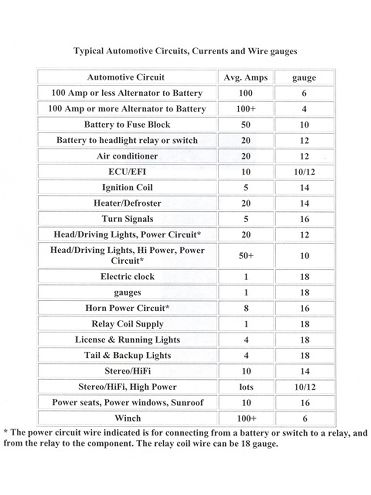 This chart gives us a great rule-of-thumb to follow when planning circuit additions or rewiring from scratch. The manufacturers of aftermarket harnesses of course construct their harnesses to exacting standards.
This chart gives us a great rule-of-thumb to follow when planning circuit additions or rewiring from scratch. The manufacturers of aftermarket harnesses of course construct their harnesses to exacting standards.
WIRE AND TERMINALS
Wires and terminals come in a variety of sizes for a reason. Higher amperage circuits require larger diameter wire and terminals of higher ratings. The same is true if you are running an extra long circuit or bundling many circuit wires together in a loom. Just like the switches, these parts need to be sized to carry the amperage and need to be able to ventilate to prevent heat buildup. Contrary to some folk's belief, soldered connections are not a necessity (though, I do prefer them), a good crimp joint is fine. In fact, if you're not careful it's very possible to overheat a solder joint causing a brittle solder connection that could break do to movement and/or vibration. The OEM's as-a-rule use crimp joints for everything including many main battery connections without a problem.
Again, every single piece in a circuit has the total amperage running through it and needs to be sized accordingly. The things to consider when selecting a wire size and insulation are the ambient temperature, the current the wire will be carrying, the total length of the wire, and how much voltage loss is acceptable. (There is always some loss, the longer the wire, or the smaller the wire, the more the loss.) As a general rule sensitive circuits and headlights can tolerate 3 percent loss, and most everything else can tolerate 10 percent loss. Headlights are sensitive because the light output varies as the square of the voltage or more, so if you want the best light output you can get, use a heavier gauge wire and use a relay. Also, EFI, ECU, and Stereo systems have a high peak current requirement that demands a larger wire size.
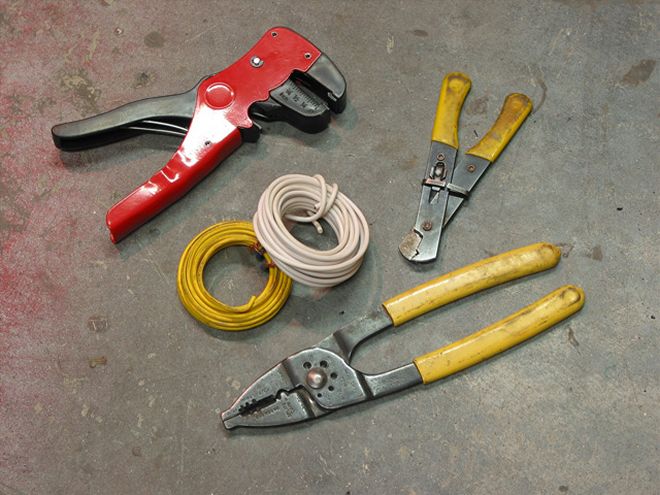 Some of the tools you should have on hand whenever doing any kind of wiring are a good set of wire strippers, wire of the correct gauge for the job, and a good set of crimping pliers.
Some of the tools you should have on hand whenever doing any kind of wiring are a good set of wire strippers, wire of the correct gauge for the job, and a good set of crimping pliers.
WIRING TOOLS
Anyone that's going to attempt a major, or minor for that matter, wiring job should invest in the proper tools. Quality wire strippers, terminal crimpers, a good test light, and soldering gun beat the heck out of stripping wire with a penknife or your teeth, crimping terminals with a pair of pliers, assuming a circuit is live, and soldering with a cigarette lighter.
THE NUMBER ONE PROBLEM
You can just about bet that the cause of 90 percent of all automotive electrical gremlins is caused by a bad grounding situation. Always keep in mind that a circuit, any circuit, has to be complete. This means that the current has to be able to travel from true ground to the positive side of the energy source in order to operate. Never rely on just the negative battery cable as the only ground, always incorporate a separate ground from the engine block to the chassis.